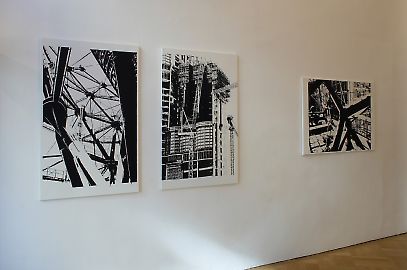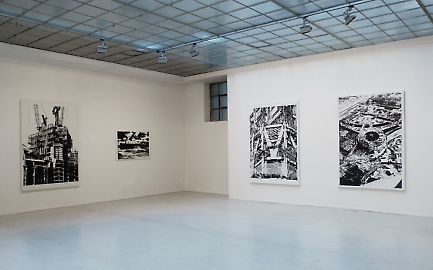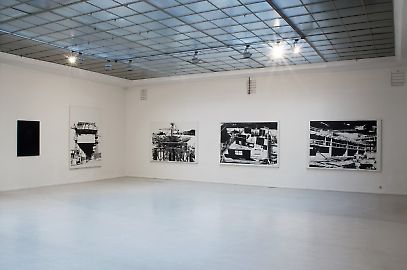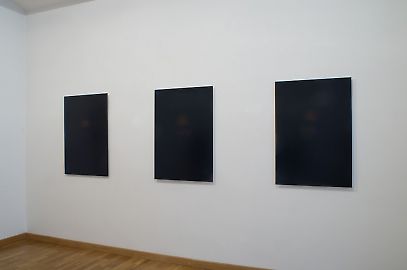Herwig Kempinger -- Transform
Herwig Kempinger, who has worked for years with the vision machine camera and the wish machine computer in elaborate apparative procedures, now returns to the most primal of all conceivable artistic methods: to brush and paint.
For Kempinger construction sites are the biggest, most overwhelming temporary staged productions we have today. On watercolor paper or canvas he projects slides of photos onto it, which have been previously manipulated on the computer. They are traced in black watercolor paint in a contrasting positive/negative. He leaves something out here, inserts something else there, briefly enjoys a symbiotic relationship, until he has completely digested and assimilated the alien, entirely in the Brazilian Oswald de Andrade’s sense. With the manual transfer into a different medium, the photo ultimately becomes his, his own image: photography as service provider.
Kempinger, who was long considered a hardliner of abstraction, once again directs his gaze to the primary location of the visible: the natural world. Which is naturally not intended to remain so natural, since in the end it is always a matter of the image’s capacity for manipulation. With meticulously differentiated corrections, which sometimes apply to the composition and never the picture segment, Kempinger improves reality, transforms it in the light of the projector into its surrogate. The hard contrasts and precise lines imbue Kempinger’s watercolors with an attractiveness and immediacy. Their stage-like presence resembles that of photography. The superstructures of the construction site architecture are deserted, solitary and abandoned, a reference to the phantom pain of Giorgio de Chiricos pittura metafisica, but also to Giovanni Battista Piranesi’s Carceri, the ruins, whose allegorical function is revealed in perfectly staged decay.
The models of Constant’s architectural vision of New Babylon suggest an open system of conjoined sectors owing to a familiarity with derelict urban areas, ruins and slums. Herwig Kempinger has similarly reflected on the conjoining of a matrix into a system with an unlimited expanse and has the papers hung in great number as densely as possible in the space. Suspended urban architectures are to emerge in a spatial network filled with many levels. “The watercolors also work as single pictures, but they work better as a group,“ says the artist. "Then they become clearer in their disturbing atmosphere.“ The construction site paintings also move in the twilight zone between fact and fiction. In this sense, the watercolors are a commentary on absence and a new interpretation of displacement.
The richness of the image information in the construction site watercolors now calls to mind the opposite of disturbance, taking comfort in the real. Yet there is nothing comforting in sight. “Uncanny is the name for everything that ought to have remained secret and hidden but has come to light,“(1) says Freud. And we enter into a transit space, a space of somewhere and nowhere. Spatial phobias, claustrophobia and vertigo threaten the viewer from distorted photographic perspectives. Gordon Matta Clark’s wounded and injured rooms are not far away. In a confusing way, Kempinger transforms commonplace, even banal and familiar architectonic situations into cryptic tableaux, inhabited by at least a certain worry, if not a fullblown fear. Perhaps it is that simple: a photo of reality seems more familiar than a reality that has been “painted out“ of the photo.
Since 2004 Kempinger has been creating photographic works that he calls part of Temporary Volumes. These are small bubbles that are constantly changing, that emerge and vanish again, imbued with permanence only through a click with the camera. The artist sees these photographs in an immediate conceptual proximity to the construction site watercolors and as a continuation of his studies on immateriality.
It would be presumptuous to attribute a pleasure in alchemistic metaphors to Herwig Kempinger, who is considered one of the most radical finalists of object reference and narration. Like his brother in spirit, Ed Ruscha, he uses visual material laconically, dispenses with narrative brackets or other condensations of subject matter.
(1) Sigmund Freud, Das Unheimliche, 1919 [The Uncanny]







